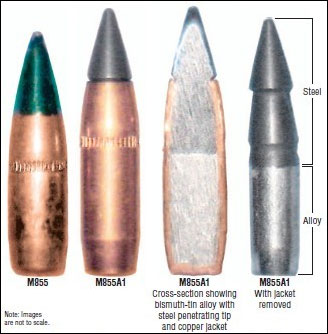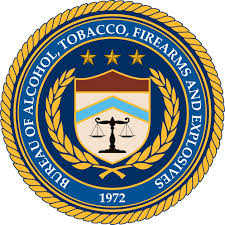(A) The term “ammunition” means ammunition or cartridge cases, primers, bullets, or propellant powder designed for use in any firearm.
(B) The term “armor piercing ammunition” means:
(i) a projectile or projectile core which may be used in a handgun and which is constructed entirely (excluding the presence of traces of other substances) from one or a combination of tungsten alloys, steel, iron, brass, bronze, beryllium copper, or depleted uranium; or
(ii) a full jacketed projectile larger than .22 caliber designed and intended for use in a handgun and whose jacket has a weight of more than 25 percent of the total weight of the projectile.
(C) The term “armor piercing ammunition” does not include shotgun shot required by Federal or State environmental or game regulations for hunting purposes, a frangible projectile designed for target shooting, a projectile which the Attorney General finds is primarily intended to be used for sporting purposes, or any other projectile or projectile core which the Attorney General finds is intended to be used for industrial purposes, including a charge used in an oil and gas well perforating device.
The ATF has recently received a number of applications seeking an exemption from the armor piercing definition. These are primarily the result of laws passed in California to ban the use of lead in traditional ammunition. It is acknowledged in these applications that the ammunition technically meets the definition of armor piercing because of the composition of the core. Once ammunition meets the technical definition, the ATF can only exempt the ammunition if the ammunition is primarily intended for a “sporting purpose.” The proposed ATF regulation can be read on the ATF website at this link.
However, in this instance, the ATF has overstepped its authority. The M855 cartridge does not meet the definition of armor piercing. Therefore, an exemption is not needed and was not needed when it was originally sought. The core of M855 is primarily lead with a steal penetrator of approximately 10 grains. This is a far cry from being “constructed entirely” of steel with lead being just a trace element. Further, the jacket comprises only about 17% of the total weight of the projectile. Congress has not given the ATF authority to ban ammunition that does not meet the definition just because the ammunition can be used in a handgun or because it is not primarily for a sporting purpose.
Further, M855 ammunition, like all 223/5.56 ammunition and most rifle ammunition and some handgun ammunition, will defeat soft body armor. However, the ATF has no realistic expectation that lives will be saved by banning M855 ammunition as armor piercing. The FBI’s Law Enforcement Officers Killed and Assaulted annual report shows that of the 535 Officers feloniously killed from 2003 to 2012 (the most current statistics), only 92 were killed with rifles. Of those killed with rifles, only 5 were killed by a rifle chambered in .223/5.56mm. Of the 21 officers killed as a direct result of body armor penetration (identified as the round fired exceeding the armor’s protection rating), only one was killed as a result of total body armor failure.
ammunition, will defeat soft body armor. However, the ATF has no realistic expectation that lives will be saved by banning M855 ammunition as armor piercing. The FBI’s Law Enforcement Officers Killed and Assaulted annual report shows that of the 535 Officers feloniously killed from 2003 to 2012 (the most current statistics), only 92 were killed with rifles. Of those killed with rifles, only 5 were killed by a rifle chambered in .223/5.56mm. Of the 21 officers killed as a direct result of body armor penetration (identified as the round fired exceeding the armor’s protection rating), only one was killed as a result of total body armor failure.
So what is the real threat caused by the ATF proposal. The ATF is seeking comment on a “framework” for determining whether to grant an exemption for ammunition meeting the definition of “armor piercing.” However, pursuant to that framework, it appears the ATF will first identify whether ammunition has a “sporting purpose” prior to determining whether the ammunition meets the definition of armor piercing. If the ammunition is not deemed to have a sporting purpose, it would appear the ATF will then make a determination whether or not to ban the ammunition. However, this type of analysis puts the cart before the horse.
In the case of M855 ammunition, the ATF, applying its new framework, is proposing that the M855 ammunition does not meet the sporting purpose test for purposes of obtaining an exemption. Therefore, the ATF is seeking to remove the exemption previously granted to M855 ammunition and as a result, the ATF will ban the ammunition. The ATF has ignored the fact that M855 ammunition does not meet the definition of armor piercing.
If the ATF is able to ban ammunition that does not technically meet the definition of armor piercing and is not even likely to result in an increase in the safety and protection of law enforcement, the ATF is grabbing power not granted to it by Congress. The ATF is basically seeking to ban ammunition, not based on the definition of armor piercing, but solely because the ammunition can be fired from a handgun that can hold more than 1 round and the ammunition can pierce soft body armor. This is a fairly easy test for the ATF to meet; especially given that the AR-15 and the AR-10 are merely platforms for constructing a variety of firearms chambered in a large variety of rifle calibers, including 223 Rem, 5.54 x 39mm, 243 Win, 300 AAC, 6.5mm Grendal, 6.8mm SPC, 7.62x 39mm, 308 Win, 458 SOCOM, and on and on.
To oppose this proposed rulemaking, you can submit comments in any of three ways:
By email: APAComments@atf.gov
By fax: (202) 648-9741, or
By mail: Denise Brown, Mailstop 6N-602, Office of Regulatory Affairs, Enforcement Programs and Services, Bureau of Alcohol, Tobacco, Firearms, and Explosives, 99 New York Avenue, NE, Washington, DC 20226: ATTN: AP Ammo Comments.
The comments must be received by the ATF by March 16, 2015 in order to guaranty that they will be considered. Points that you may want to make in your comments to the ATF include:
1. M855 ammunition does not meet the technical definition of armor piercing because it does not have a core made entirely of the specified metal and its jacket does not make up more than 25% of the total projectile weight. Therefore, even if the ATF adopts this framework and removes the exemption that was previously granted, M855 ammunition will still be permitted to be manufactured and sold to the general public.
2. M855 ammunition is no more effective at defeating soft body armor than any other 22 caliber projectile, most other rifle ammunitions, and some common handgun ammunitions. It is disingenuous to believe that attempting to ban M855 ammunition will save lives or protect law enforcement officers.
3. Because M855 ammunition was originally intended to be used in rifles, handguns that have been designed to chamber 5.56 NATO ammunition are not easily concealable and therefore, do not fall within the type of handguns originally envisioned by Congress when it adopted the LEOPA.
4. FBI crime statistics related to law enforcement officers feloniously killed in the line of duty do not reflect that M855 is an additional threat to lives or safety of law enforcement officers.
5. Similar ammunition, used in the same handguns, is not within the power of the ATF to ban even though that ammunition can also penetrate soft body armor. Therefore, attempting to ban M855 ammunition will have no effect in protecting lives or safety of law enforcement officers from criminals. Contrary to the proposed rulemaking, the ATF is ignoring the very purpose for which the LEOPA was enacted. The only real effect of banning M855 will be to increase the cost of ammunition for law-abiding citizens who use the ammunition in both rifles and handguns for recreational shooting and other sporting purposes.
6. The ATF acknowledges that M855 was developed for military and law enforcement applications. Interrupting the supply of M855 through an attempt on banning the importation, manufacture, and sale of M855 will adversely affect National Security and will increase costs to the Federal, State, and Local Governments with no affect in protecting lives or safety of law enforcement officers from criminals. It is clear that M855 does not meet the LEOPA/GCA definition of armor piercing and tax dollars and time wasted by the ATF trying to force companies to stop manufacturing and selling M855 will only adversely affect the Government and cause interruptions in supply and additional costs to the Government.
7. Because of commercial sales of M855 ammunition, more companies are willing to manufacture the ammunition making the ammunition readily available in times of war at little risk to the Government of a supply interruption. In addition, because excess manufacturing capability can be sold commercially, the price to Federal, State, and Local Governments is less due to lower per unit production costs as well as competition in the industry.
_____________________________
* Michael W. Zarlenga is an attorney serving as Of Counsel in the Washington, DC office of Arsenal Attorneys and the law firm of Bergstrom & Taylor. Mr. Zarlenga is licensed as an attorney in Ohio and the District of Columbia. Mr. Zarlenga has been a firearms dealer holding a Federal Firearms License since 2002 and is an avid shooter and hunter. Mr. Zarlenga concentrates on corporate, contract, and regulatory matters for businesses, including businesses in the firearms industry.

 B
B
